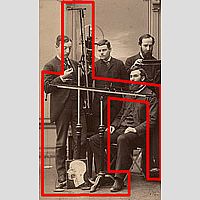
|

|



|
|
Apparatus for the Investigation of the Muscular Sense
|
| |
Source |
|
[Ruf, C.]. 1892. Münsterberg's Laboratory in Freiburg, Germany. Photograph. (Harvard University Archives - HUP Munsterberg, Hugo, 1BP, box 13)
 |
| |
People |
|
Elbs, Hermann (1861 - 1936) |
| |
Sites |
|
Psychological Laboratory, University of Freiburg (1891) |
| |
Related Literature |
|
Elbs, Hermann. 1895. Abzug der Instrumente. Freiburg (Collection Rand B. Evans),
table.
Delabarre, Edmund Burke. 1891. Über Bewegungsempfindungen. Freiburg in Baden: Epstein, table.
Krohn, William O. 1891. Facilities in Experimental Psychology at the various German Universities. American Journal of Psychology 4: 585-594, on p.587
MacDonald, Arthur. 1898. Experimental study of children: including anthropometrical and psycho-physical measurements of Washington school children , on p.1151. |
| |
Comment |
|
Note that there are two apparatuses shown in the photograph, one in vertical, the other one in horizontal position. The device in vertical position only uses one weight (see a figure in MacDonald, 1898, p.1151), whereas the other one in horizontal position is provided with two.
Krohn (1891, see related literature) describes the instrument as follows:
"1. Muskelsinnapparat. [...] Into a heavy iron stand moves a strong iron rod a little over an inch in thickness, which
can be easily elevated or lowered at will, and by means of a screw can be held any height, something on the principle of a music stand or modern piano lamp. Above on this stand, arranged to turn about an axis, is the portion of the apparatus which is more immediately concerned in
the experiment. This consists of two small rails, upon which runs a light easily moved car with four small brass wheels. In order to hold the car fast upon the track at any chosen position or angle, there extends out from the under side a piece of metal, which has upon the end a small wheel, that runs along the under side of a third rail. This third rail is midway between and a little above the other two. To the car is attached an indicator, the point of which indicates the position of the car upon a scale 900 mm. long. This scale is fastened upon the side of one of the outer rails and divided into half centimeters; millimeters can easily be measured with the eye. To the top of the car is attached a short hollow brass cylinder, into which the end-joint of the index finger can be placed in order to set the car in motion. Upon the middle track are two clamps, which in every chosen position can be fixed as limits for the movements of the car, if such limits are desired. At each end of the middle track are little pulley wheels, over which a string can be drawn, which is fastened at one end to the little car and at the other to a scale pan, which is used in experiments where the weight of the wagon is to be compensated or where the movement of the car by means of a weight is to be made more difficult or easier. The portion of the apparatus consisting of the rails and car is movable about an axis and can be made to stand at any angle between the horizontal and vertical position. Thus the car can be moved horizontally or vertically, or at any incline. By means of the compensating weights in the scale pan, the resistance of the moving car is almost entirely done away with. The apparatus is well made and lends itself to a multitude of conditis exceedingly useful for many purposes. Price 130 marks." |
| |
Description |
|
|
|
ISSN 1866-4784: reference -
xlink
|
|
| |